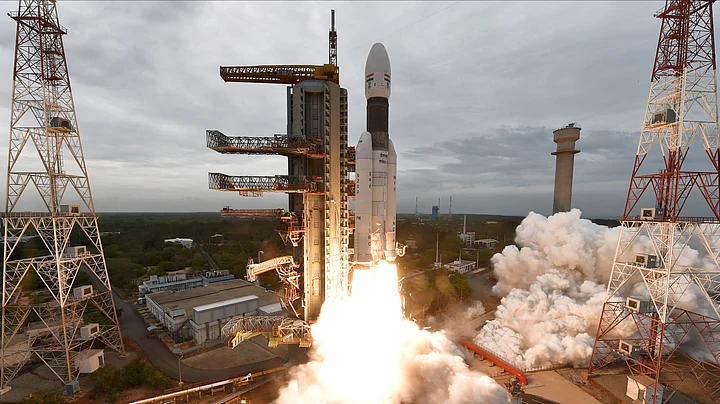India’s first moon lander, Vikram, successfully separated from its mother spacecraft Chandrayaan-2 on Monday, 2 September, at 1:15 am. It is scheduled to land on the south polar region of the moon on 7 September, between 1:30 am and 2:30 am.
After the moon touchdown by Vikram, the rover – Pragyan – will roll down from it to carry out research for which it was designed. It will operate there for 14 days, carry out experiments and collect data samples for further assessment.
The mission will see the lander and rover module of the spacecraft make a soft landing on the lunar surface 48 days from its date of launch, which was 22 July.
But why 48 days? Why was’t it faster? Well, that’s because Chandrayaan-2 is powered by the GSLV MK-III, which is a relatively inexpensive, low-power engine that can lift only 8,000 Kg into low-earth orbit (LEO) and half that weight into higher orbits.
Compared to this, Space X’s Falcon 9 can carry nearly 23,000 Kg, while the Saturn V rocket of the Apollo mission that took Neil Armstrong to the Moon, could haul a massive 118,000 Kg to LEO.
In layperson terms, that’s like riding to the Moon on a Hero Splendor (which gives great mileage) compared to a Suzuki Hayabusa.
Time Taken for Other Missions to Reach the Moon
- China’s Chang’e 1: Four days, 12 hours
- NASA Apollo 11: Four days
- Russia’s Luna 15: Four days
Chandrayaan-2 spent the first few days after launch circling the earth, incrementally raising its orbit, before starting its journey for over seven days to enter an orbit around the Moon. The launcher and the lunar craft on the Saturn V rocket used powerful engines to reach Moon, covering 3.8 lakh km in just four days.
We need to understand that the Apollo missions were also designed to carry astronauts, while Chandrayaan-2 is a smaller, uncrewed mission, looking to explore the south pole of the moon, where none have landed so far.
Post the entry into the initial orbit, the duty of managing and tracking Chandrayaan-2 is now with the ISRO Telemetry, Tracking and Command (Istrac) centre in Bengaluru, as highlighted in this Times of India report.
During the course of mission, Istrac will be guiding the spacecraft to Moon, help it land and unload the rover. For this, Istrac will be using ground stations across different parts of the world.
The same report also specified that if Chandrayaan-2 had launched without a glitch on 15 July, it would have reached lunar orbit in 22 days and gone around the moon for 28 days.
But as per the new schedule, since its launch on 22 July, the module comprising of the lander and the rover will remain in the 100km x 100km orbit for 13 days.
Let’s Talk Money
Comparing NASA and ISRO projects have become the favourite pass time for a lot of people over the past month or so. But clearly, what they don’t realise is the ‘David vs Goliath’ nature of this comparison.
As highlighted by Times of India in this report, NASA pumped over $185 (converts to $1.2 billion in 2016) for each Apollo mission between 1969 and 1971. Out of its total budget, NASA spent $110 million on building every Saturn V spacecraft.
Whereas ISRO has invested Rs 978 crore, which converts to $138 million in 2019. Out of this, Rs 375 crore ($142 million) was spent on building the GSLV Mk-III rocket. Put these numbers into perspective and you can imagine how the Indian space agency is pulling off yet another mission at fraction of the cost of what NASA spent in the late 1960's.
When Science Precedes Technology
ISRO had to overcome tremendous challenges to build the GSLV MK-III launch vehicle, which has taken decades of scientific and technological groundwork.
ISRO Chairman K Sivan, as quoted in this Indian Express report, said that for this mission, the performance of the GSLV MK-III has been increased by 15 percent compared to the previous missions.
But even that pales in front of the capability of other rockets that have attempted to reach the Moon, as we’ve mentioned above.
This places heavy emphasis on the Chandrayaan II (GSLV MK-III) to opt for a conservative route to complete its mission.
Which means, instead of pushing the GSLV MK-III full throttle, ISRO is guiding the spacecraft to take multiple orbits, to get closer to the Moon, which is called the Oberth effect. ISRO Chairman, quoted in this Times of India report, elucidates this process further.
“The spacecraft requires a minimum velocity of 11km/second to go to Moon. Of that, 10.3km/second is provided by the vehicle and 700m/second is being provided by the craft’s propulsion system. Being a small engine, we are burning the engine not continuously but in short bursts to manoeuvre the craft. If we had a powerful engine like Saturn V, we could have reached moon in a single shot.”K Sivan, Chairman, ISRO to Times of India
With each orbit, the spacecraft moved away from the gravitational pull of the Earth and finally entered the Moon’s orbit, after which the spacecraft can start its unloading cycle of the lander and the rover.
The same strategy was put into use by ISRO for the Mangalyaan Mission, using the PSLV-C25 launch vehicle, launched on 5 November 2013.
Hence, keeping the trajectory of the mission and the overall capability of the GSLV MK-III in mind, the duration to accomplish the task of landing on the lunar south pole is taking longer than other missions, and understandably so.
